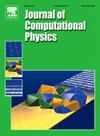High-order moment-based Hermite WENO schemes for hyperbolic conservation laws on triangular meshes
IF 3.8
2区 物理与天体物理
Q2 COMPUTER SCIENCE, INTERDISCIPLINARY APPLICATIONS
引用次数: 0
Abstract
In this paper, we construct high-order Hermite weighted essentially non-oscillatory (HWENO) schemes for two-dimensional hyperbolic conservation laws on triangular meshes. These schemes integrate both zeroth- and first-order moments into spatial discretizations, yielding more compact stencils than same-order WENO schemes. Specifically, the third- and fifth-order HWENO schemes require only one and two layers of stencils, respectively, as opposed to the two layers needed by a third-order WENO scheme. Meanwhile, the HWENO schemes demonstrate reduced numerical errors in smooth areas and improved resolutions near discontinuities. Although the HWENO schemes include two auxiliary equations, they retain a unified nonlinear reconstruction process similar to that of WENO schemes. This design choice leads to a modest increase in computational expense and algorithm complexity. Crucially, an efficient definition of smoothness indicators is introduced, based on a midpoint numerical integration of the original definition. This streamlined definition enhances computational efficiencies on unstructured meshes and results in only minor variations in smoothness measurement between the two definitions, regardless of whether the problem is smooth or discontinuous. The HWENO schemes are distinguished by their strong practicality on triangular meshes, with efficient computation of smoothness indicators, consistent use of a single set of compact stencils, and application of artificial linear weights. Extensive numerical experiments are conducted to verify the high-order accuracies, efficiencies, resolutions, robustness, scale-invariance, and the effectiveness of the smoothness indicator for the proposed HWENO schemes.
三角网格上双曲守恒律的高阶矩Hermite WENO格式
本文构造了三角形网格上二维双曲守恒律的高阶Hermite加权本质非振荡(HWENO)格式。这些方案将零阶和一阶矩集成到空间离散化中,产生比同阶WENO方案更紧凑的模板。具体来说,三阶和五阶WENO方案分别只需要一层和两层模板,而三阶WENO方案则需要两层。同时,HWENO方案在光滑区域的数值误差减小,在不连续区域附近的分辨率提高。虽然HWENO格式包含两个辅助方程,但它们与WENO格式保持了统一的非线性重建过程。这种设计选择导致计算费用和算法复杂性的适度增加。最重要的是,在原始定义的中点数值积分的基础上,引入了平滑度指标的有效定义。这种简化的定义提高了非结构化网格的计算效率,并且无论问题是光滑的还是不连续的,两种定义之间的平滑度测量只有很小的变化。HWENO方案的特点是在三角形网格上具有很强的实用性,平滑度指标的高效计算,始终使用一组紧凑的模板,并应用人工线性权值。通过大量的数值实验验证了所提出的HWENO方案的高阶精度、效率、分辨率、鲁棒性、尺度不变性和平滑指标的有效性。
本文章由计算机程序翻译,如有差异,请以英文原文为准。
求助全文
约1分钟内获得全文
求助全文
来源期刊

Journal of Computational Physics
物理-计算机:跨学科应用
CiteScore
7.60
自引率
14.60%
发文量
763
审稿时长
5.8 months
期刊介绍:
Journal of Computational Physics thoroughly treats the computational aspects of physical problems, presenting techniques for the numerical solution of mathematical equations arising in all areas of physics. The journal seeks to emphasize methods that cross disciplinary boundaries.
The Journal of Computational Physics also publishes short notes of 4 pages or less (including figures, tables, and references but excluding title pages). Letters to the Editor commenting on articles already published in this Journal will also be considered. Neither notes nor letters should have an abstract.
 求助内容:
求助内容: 应助结果提醒方式:
应助结果提醒方式:


